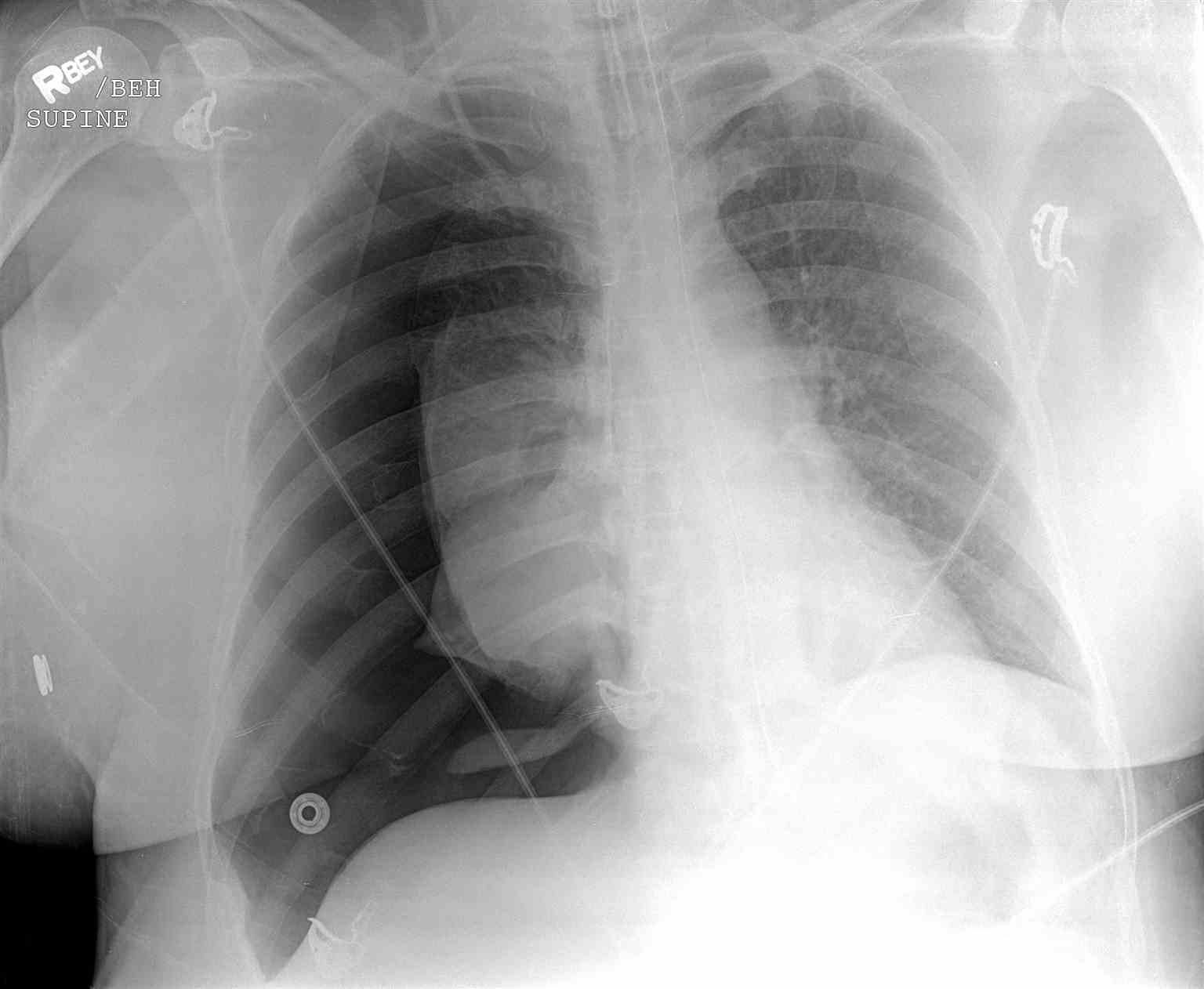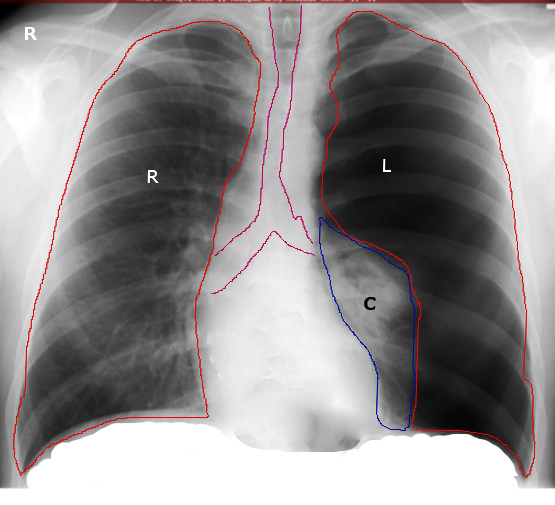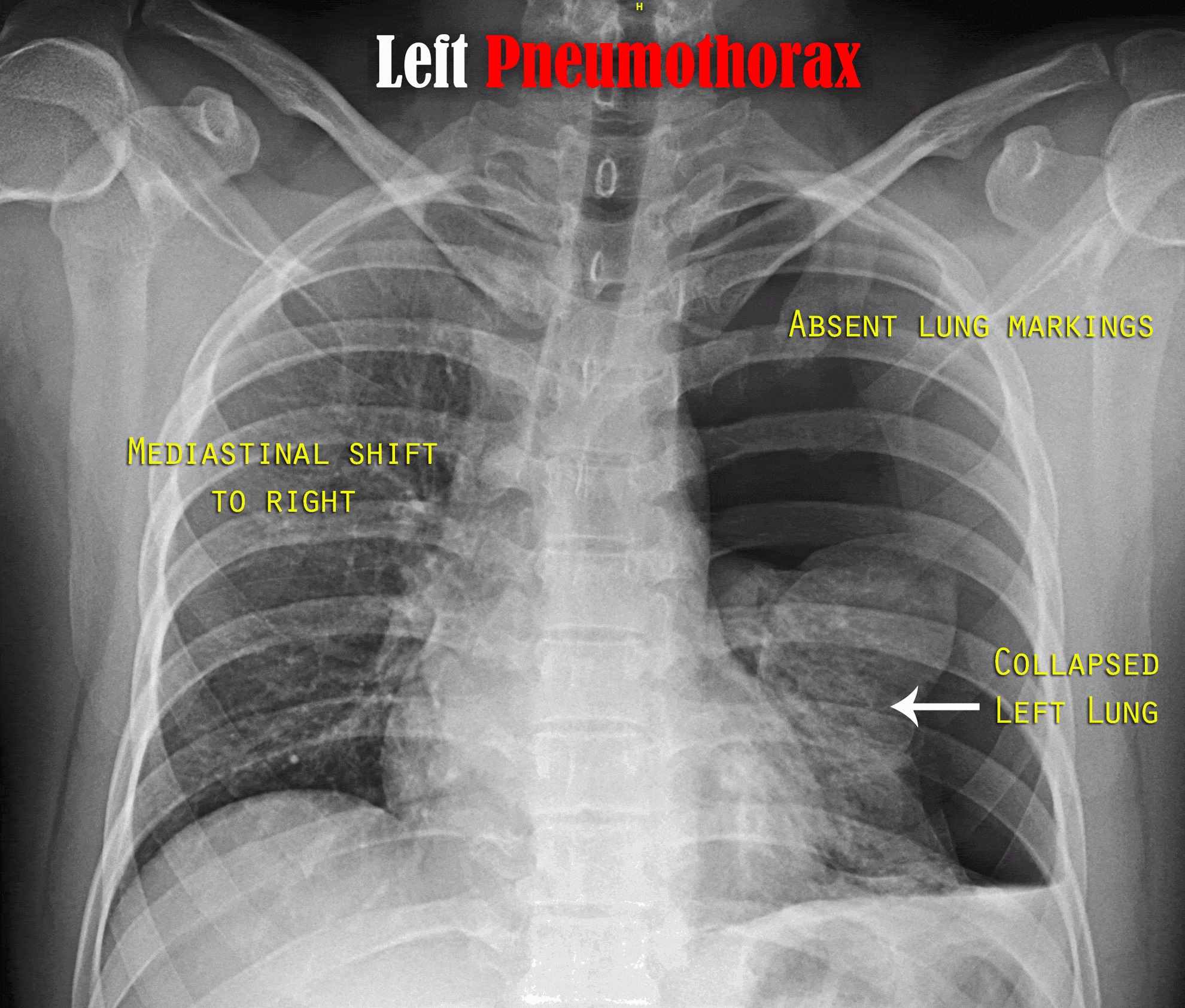[1]
Rojas R, Wasserberger J, Balasubramaniam S. Unsuspected tension pneumothorax as a hidden cause of unsuccessful resuscitation. Annals of emergency medicine. 1983 Jun:12(6):411-2
[PubMed PMID: 6859647]
[2]
ATLS Subcommittee, American College of Surgeons’ Committee on Trauma, International ATLS working group. Advanced trauma life support (ATLS®): the ninth edition. The journal of trauma and acute care surgery. 2013 May:74(5):1363-6. doi: 10.1097/TA.0b013e31828b82f5. Epub
[PubMed PMID: 23609291]
[3]
Roberts DJ, Leigh-Smith S, Faris PD, Ball CG, Robertson HL, Blackmore C, Dixon E, Kirkpatrick AW, Kortbeek JB, Stelfox HT. Clinical manifestations of tension pneumothorax: protocol for a systematic review and meta-analysis. Systematic reviews. 2014 Jan 4:3():3. doi: 10.1186/2046-4053-3-3. Epub 2014 Jan 4
[PubMed PMID: 24387082]
Level 1 (high-level) evidence
[4]
Cameron PA, Flett K, Kaan E, Atkin C, Dziukas L. Helicopter retrieval of primary trauma patients by a paramedic helicopter service. The Australian and New Zealand journal of surgery. 1993 Oct:63(10):790-7
[PubMed PMID: 8274122]
[5]
Coats TJ, Wilson AW, Xeropotamous N. Pre-hospital management of patients with severe thoracic injury. Injury. 1995 Nov:26(9):581-5
[PubMed PMID: 8550162]
[6]
Eckstein M, Suyehara D. Needle thoracostomy in the prehospital setting. Prehospital emergency care. 1998 Apr-Jun:2(2):132-5
[PubMed PMID: 9709333]
[8]
Melton LJ 3rd, Hepper NG, Offord KP. Incidence of spontaneous pneumothorax in Olmsted County, Minnesota: 1950 to 1974. The American review of respiratory disease. 1979 Dec:120(6):1379-82
[PubMed PMID: 517861]
[9]
Gupta D, Hansell A, Nichols T, Duong T, Ayres JG, Strachan D. Epidemiology of pneumothorax in England. Thorax. 2000 Aug:55(8):666-71
[PubMed PMID: 10899243]
[10]
Sharma A, Jindal P. Principles of diagnosis and management of traumatic pneumothorax. Journal of emergencies, trauma, and shock. 2008 Jan:1(1):34-41. doi: 10.4103/0974-2700.41789. Epub
[PubMed PMID: 19561940]
[11]
Toffel M, Pin M, Ludwig C. [Thoracic Surgical Aspects of Seriously Injured Patients]. Zentralblatt fur Chirurgie. 2020 Feb:145(1):108-120. doi: 10.1055/a-0903-1461. Epub 2020 Feb 25
[PubMed PMID: 32097982]
[12]
McPherson JJ, Feigin DS, Bellamy RF. Prevalence of tension pneumothorax in fatally wounded combat casualties. The Journal of trauma. 2006 Mar:60(3):573-8
[PubMed PMID: 16531856]
[13]
Vinson DR, Ballard DW, Hance LG, Stevenson MD, Clague VA, Rauchwerger AS, Reed ME, Mark DG, Kaiser Permanente CREST Network Investigators. Pneumothorax is a rare complication of thoracic central venous catheterization in community EDs. The American journal of emergency medicine. 2015 Jan:33(1):60-6. doi: 10.1016/j.ajem.2014.10.020. Epub 2014 Oct 18
[PubMed PMID: 25455050]
[14]
Tsotsolis N, Tsirgogianni K, Kioumis I, Pitsiou G, Baka S, Papaiwannou A, Karavergou A, Rapti A, Trakada G, Katsikogiannis N, Tsakiridis K, Karapantzos I, Karapantzou C, Barbetakis N, Zissimopoulos A, Kuhajda I, Andjelkovic D, Zarogoulidis K, Zarogoulidis P. Pneumothorax as a complication of central venous catheter insertion. Annals of translational medicine. 2015 Mar:3(3):40. doi: 10.3978/j.issn.2305-5839.2015.02.11. Epub
[PubMed PMID: 25815301]
[15]
El-Nawawy AA, Al-Halawany AS, Antonios MA, Newegy RG. Prevalence and risk factors of pneumothorax among patients admitted to a Pediatric Intensive Care Unit. Indian journal of critical care medicine : peer-reviewed, official publication of Indian Society of Critical Care Medicine. 2016 Aug:20(8):453-8. doi: 10.4103/0972-5229.188191. Epub
[PubMed PMID: 27630456]
[16]
Roberts DJ, Leigh-Smith S, Faris PD, Blackmore C, Ball CG, Robertson HL, Dixon E, James MT, Kirkpatrick AW, Kortbeek JB, Stelfox HT. Clinical Presentation of Patients With Tension Pneumothorax: A Systematic Review. Annals of surgery. 2015 Jun:261(6):1068-78. doi: 10.1097/SLA.0000000000001073. Epub
[PubMed PMID: 25563887]
Level 1 (high-level) evidence
[17]
Martin M, Satterly S, Inaba K, Blair K. Does needle thoracostomy provide adequate and effective decompression of tension pneumothorax? The journal of trauma and acute care surgery. 2012 Dec:73(6):1412-7. doi: 10.1097/TA.0b013e31825ac511. Epub
[PubMed PMID: 22902737]
[18]
Barton ED, Rhee P, Hutton KC, Rosen P. The pathophysiology of tension pneumothorax in ventilated swine. The Journal of emergency medicine. 1997 Mar-Apr:15(2):147-53
[PubMed PMID: 9144053]
[19]
Nelson D, Porta C, Satterly S, Blair K, Johnson E, Inaba K, Martin M. Physiology and cardiovascular effect of severe tension pneumothorax in a porcine model. The Journal of surgical research. 2013 Sep:184(1):450-7. doi: 10.1016/j.jss.2013.05.057. Epub 2013 Jun 5
[PubMed PMID: 23764307]
[22]
DORNHORST AC, PIERCE JW. Pulmonary collapse and consolidation; the role of collapse in the production of lung field shadows and the significance of segments in inflammatory lung disease. The Journal of the Faculty of Radiologists. Faculty of Radiologists (Great Britain). 1954 Apr:5(4):276-81
[PubMed PMID: 24543591]
[23]
Zhang M, Liu ZH, Yang JX, Gan JX, Xu SW, You XD, Jiang GY. Rapid detection of pneumothorax by ultrasonography in patients with multiple trauma. Critical care (London, England). 2006:10(4):R112
[PubMed PMID: 16882338]
[24]
Soldati G, Iacconi P. The validity of the use of ultrasonography in the diagnosis of spontaneous and traumatic pneumothorax. The Journal of trauma. 2001 Aug:51(2):423
[PubMed PMID: 11493817]
[25]
Shostak E, Brylka D, Krepp J, Pua B, Sanders A. Bedside sonography for detection of postprocedure pneumothorax. Journal of ultrasound in medicine : official journal of the American Institute of Ultrasound in Medicine. 2013 Jun:32(6):1003-9. doi: 10.7863/ultra.32.6.1003. Epub
[PubMed PMID: 23716522]
[26]
Zarogoulidis P, Kioumis I, Pitsiou G, Porpodis K, Lampaki S, Papaiwannou A, Katsikogiannis N, Zaric B, Branislav P, Secen N, Dryllis G, Machairiotis N, Rapti A, Zarogoulidis K. Pneumothorax: from definition to diagnosis and treatment. Journal of thoracic disease. 2014 Oct:6(Suppl 4):S372-6. doi: 10.3978/j.issn.2072-1439.2014.09.24. Epub
[PubMed PMID: 25337391]
[27]
Arao K, Mase T, Nakai M, Sekiguchi H, Abe Y, Kuroudu N, Oobayashi O. Concomitant Spontaneous Tension Pneumothorax and Acute Myocardial Infarction. Internal medicine (Tokyo, Japan). 2019 Apr 15:58(8):1131-1135. doi: 10.2169/internalmedicine.1422-18. Epub 2019 Jan 10
[PubMed PMID: 30626814]
[28]
Vallee P, Sullivan M, Richardson H, Bivins B, Tomlanovich M. Sequential treatment of a simple pneumothorax. Annals of emergency medicine. 1988 Sep:17(9):936-42
[PubMed PMID: 3137850]
[29]
Henry M, Arnold T, Harvey J, Pleural Diseases Group, Standards of Care Committee, British Thoracic Society. BTS guidelines for the management of spontaneous pneumothorax. Thorax. 2003 May:58 Suppl 2(Suppl 2):ii39-52
[PubMed PMID: 12728149]
[30]
Dominguez KM, Ekeh AP, Tchorz KM, Woods RJ, Walusimbi MS, Saxe JM, McCarthy MC. Is routine tube thoracostomy necessary after prehospital needle decompression for tension pneumothorax? American journal of surgery. 2013 Mar:205(3):329-32; discussion 332. doi: 10.1016/j.amjsurg.2013.01.004. Epub
[PubMed PMID: 23414956]
[31]
Terada T, Nishimura T, Uchida K, Hagawa N, Esaki M, Mizobata Y. How emergency physicians choose chest tube size for traumatic pneumothorax or hemothorax: a comparison between 28Fr and smaller tube. Nagoya journal of medical science. 2020 Feb:82(1):59-68. doi: 10.18999/nagjms.82.1.59. Epub
[PubMed PMID: 32273633]
[32]
Chen KC, Chen PH, Chen JS. New options for pneumothorax management. Expert review of respiratory medicine. 2020 Jun:14(6):587-591. doi: 10.1080/17476348.2020.1740090. Epub 2020 Mar 15
[PubMed PMID: 32174202]
[33]
Eguchi M, Abe T, Tedokon Y, Miyagi M, Kawamoto H, Nakasone Y. [Traumatic Intercostal Lung Hernia Repaired by Video-assisted Thoracoscopic Surgery;Report of a Case]. Kyobu geka. The Japanese journal of thoracic surgery. 2019 Nov:72(12):1038-1041
[PubMed PMID: 31701918]
Level 3 (low-level) evidence
[34]
Johnson G. Traumatic pneumothorax: is a chest drain always necessary? Journal of accident & emergency medicine. 1996 May:13(3):173-4
[PubMed PMID: 8733651]
[35]
Paydar S, Ghahramani Z, Ghoddusi Johari H, Khezri S, Ziaeian B, Ghayyoumi MA, Fallahi MJ, Niakan MH, Sabetian G, Abbasi HR, Bolandparvaz S. Tube Thoracostomy (Chest Tube) Removal in Traumatic Patients: What Do We Know? What Can We Do? Bulletin of emergency and trauma. 2015 Apr:3(2):37-40
[PubMed PMID: 27162900]
[36]
van den Brande P, Staelens I. Chemical pleurodesis in primary spontaneous pneumothorax. The Thoracic and cardiovascular surgeon. 1989 Jun:37(3):180-2
[PubMed PMID: 2763278]
[37]
Huang TW, Lee SC, Cheng YL, Tzao C, Hsu HH, Chang H, Chen JC. Contralateral recurrence of primary spontaneous pneumothorax. Chest. 2007 Oct:132(4):1146-50
[PubMed PMID: 17550937]
[38]
British Thoracic Society Fitness to Dive Group, Subgroup of the British Thoracic Society Standards of Care Committee. British Thoracic Society guidelines on respiratory aspects of fitness for diving. Thorax. 2003 Jan:58(1):3-13
[PubMed PMID: 12511710]
[39]
Hsu CW, Sun SF, Lee DL, Chu KA, Lin HS. Clinical characteristics, hospital outcome and prognostic factors of patients with ventilator-related pneumothorax. Minerva anestesiologica. 2014 Jan:80(1):29-38
[PubMed PMID: 24122035]
[40]
Chen KY, Jerng JS, Liao WY, Ding LW, Kuo LC, Wang JY, Yang PC. Pneumothorax in the ICU: patient outcomes and prognostic factors. Chest. 2002 Aug:122(2):678-83
[PubMed PMID: 12171850]



